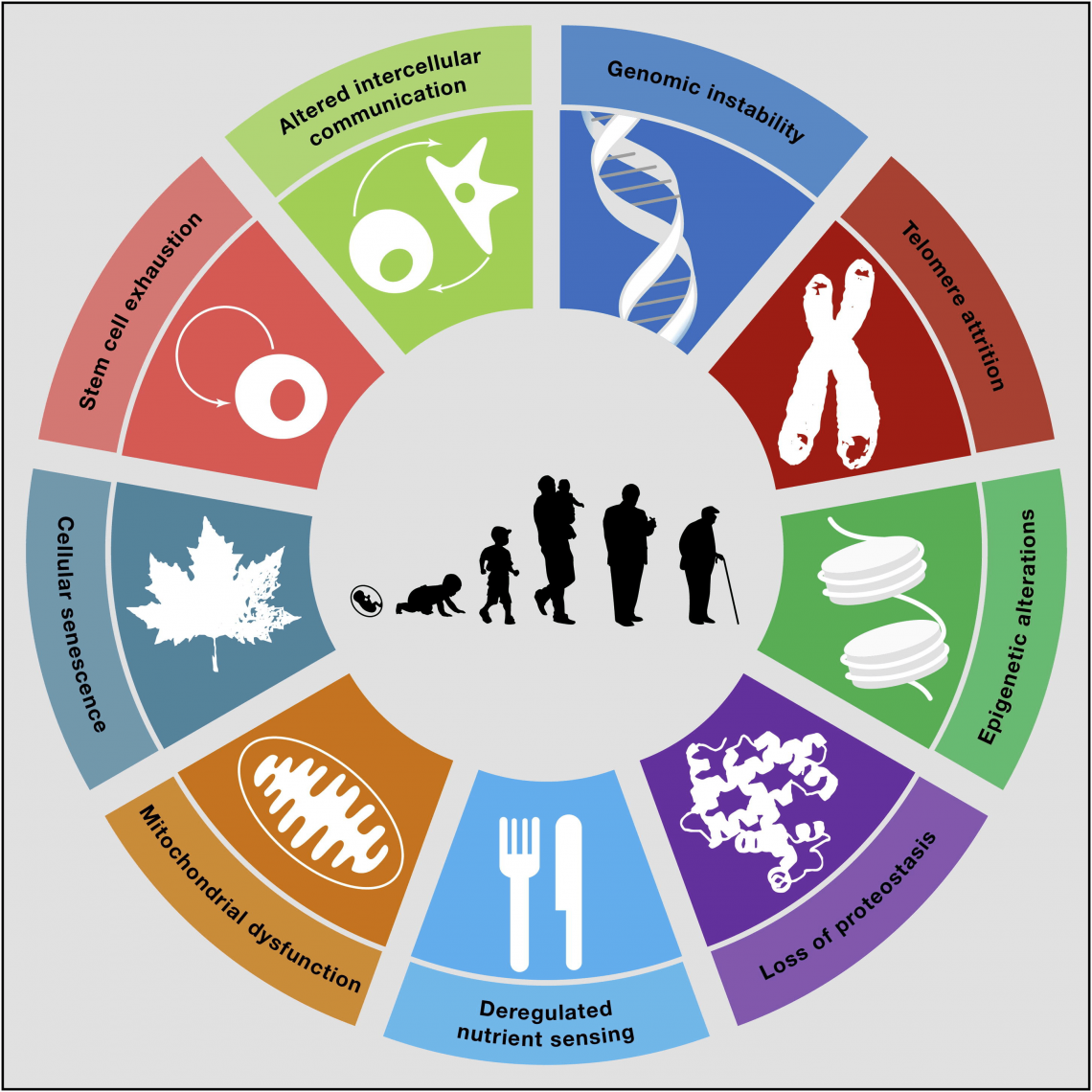
The above diagram depicts the various pillars of aging. Unfortunately, these causes of aging seem to gang-up on an individual. When we look at aging we need to look at “Hallmarks of Aging”. The next diagram is an excellent synopsis of Aging. It demonstrates what I call the upstream causes of aging. We can see the primary hallmarks of aging. The first four niches represent the true upstream causes of aging. The other five hallmarks are responses to aging. Any of the above are capable to cause us to age more rapidly. Intervention in any of these hallmarks can have significant effects on the aging process especially the first four, the true upstream causes of aging.
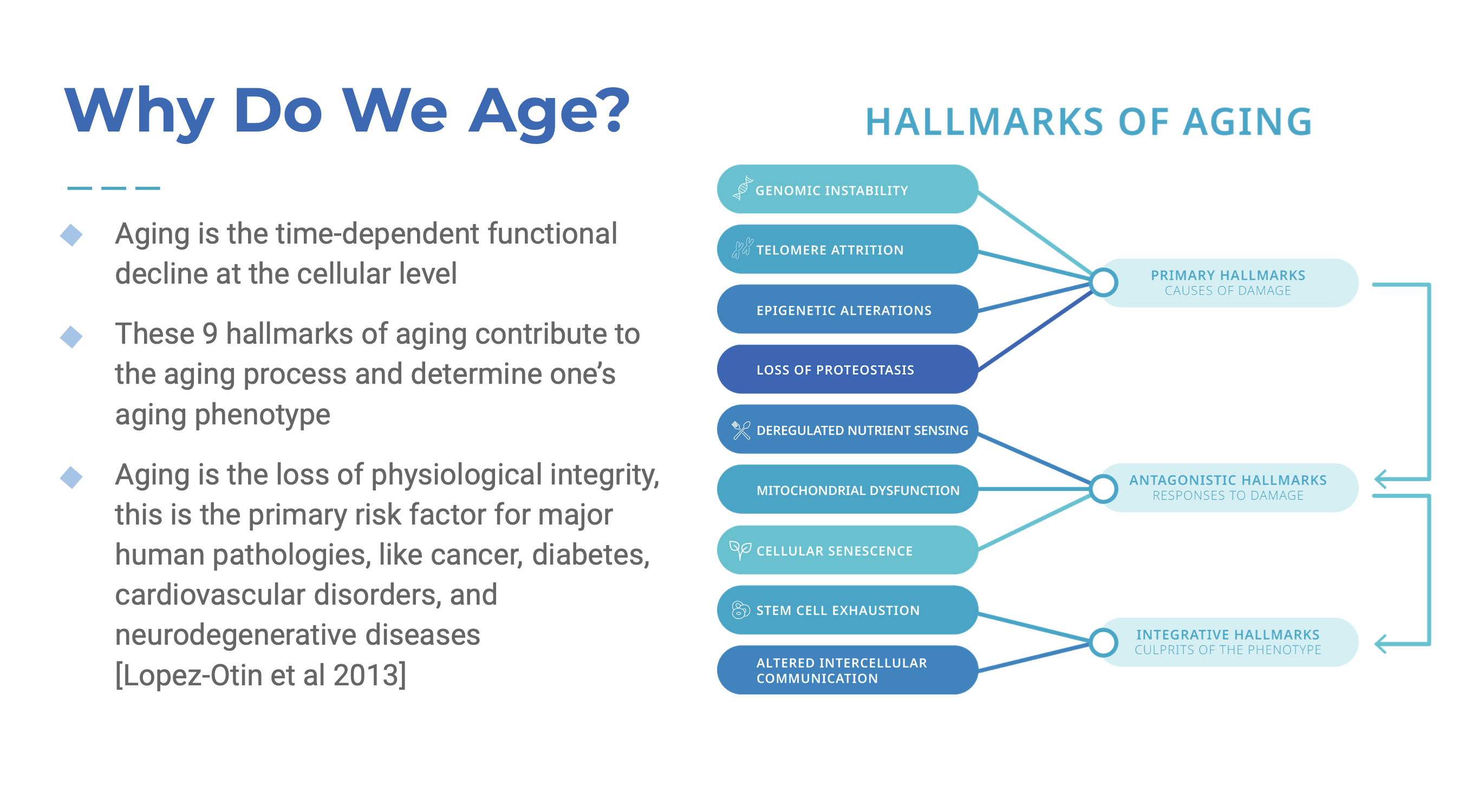
The real question becomes what biomarkers (a measurable substance in an organism whose presence is indicative of some phenomenon such as disease, infection, or environmental exposure) can be used to predict and measure aging? The following diagram is a take-off of the first diagram showing a variety of biomarkers. The question at hand is which of these biomarkers can be of benefit in predicting and slowing down aging and showing disease risk in a practical sense. More importantly, can it demonstrate if in fact that certain modalities are slowing down aging?
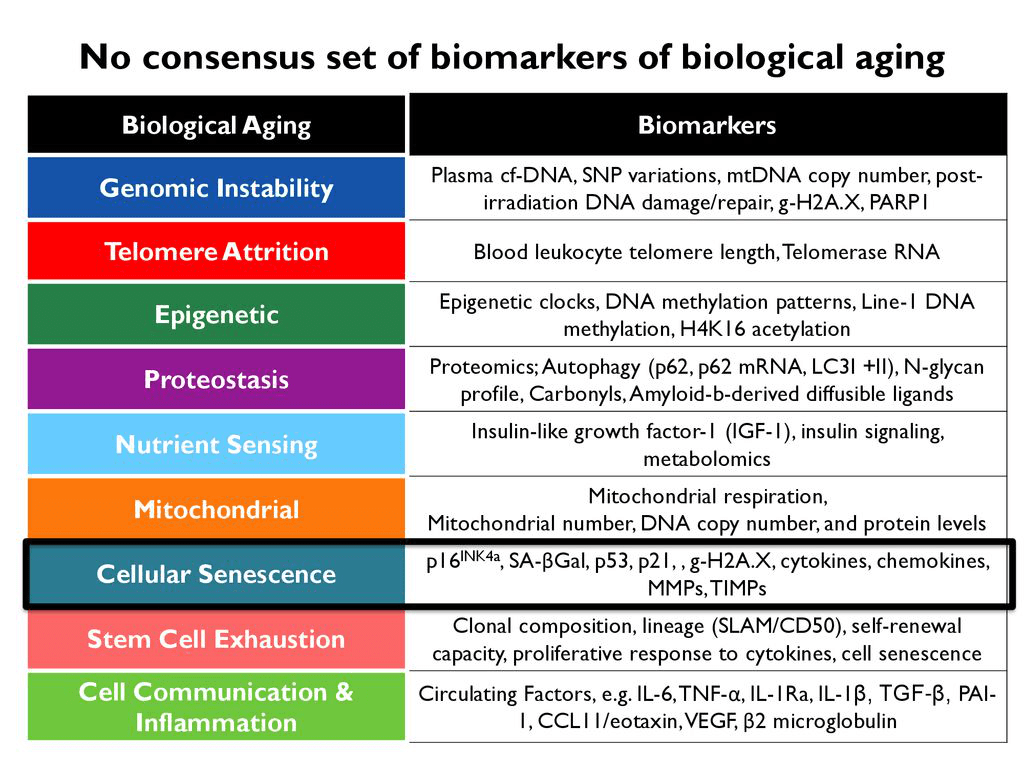
Aging is the biggest risk factor for all chronic diseases including arthritis, cancer, heart disease, diabetes, Alzheimer’s, Parkinson’s and many more. The problem is that there is no good consensus on what biomarkers to use to measure aging. The preceding diagram shows some of the biomarkers utilized yet there is much controversy as to which are the most important and practical.
There are two kinds of age: chronological age, which is the number of years one has lived, and biological age, which is influenced by our genes, lifestyle, behavior, the environment and other factors. Biological age is the superior measure of true age and is the most biologically relevant feature, as it closely correlates with mortality and health status. The search for reliable predictors of biological age has been ongoing for several decades, and until recently, largely without success. They may be part of the of the Holy Grail of Anti-Aging.
The above diagram is an attempt to give some ideas of what can be utilized as biomarkers of aging. The biomarkers are very complicated and may not actually be all that reliable. Some are very well known while others are esoteric. Let us look at the more well-known markers of aging.
TELOMERES
Telomeres are DNA timers that limit the lifespan of a single cell. On the individual cell level, telomeres are the best marker of aging. However, we are composed of trillions of cells and each of them has different age and expected lifespan. Some studies show that there may be some importance on Telomere aging of the immune system. A recent large study concluded that telomere tests are not a good predictor of age-related health status. At one time Telomere testing was considered the gold standard of age assessment. I still consider it an important test but now there are other tests that may give us a better picture of aging.
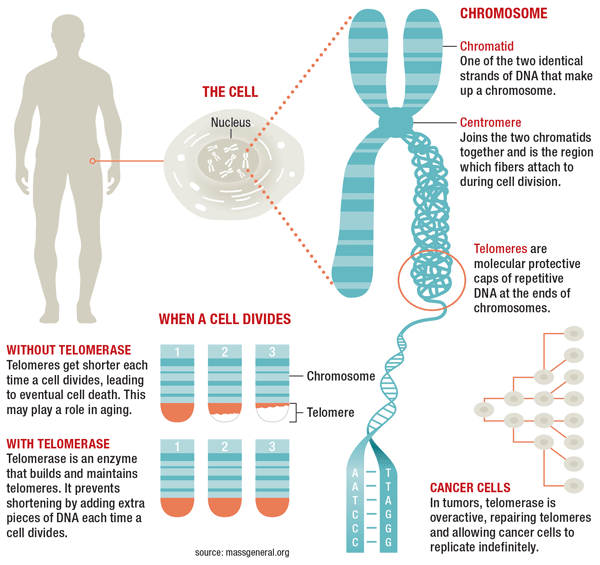
A recent large study concluded that telomere tests are not a good predictor of age-related health status. It is an important test but now there are other tests that may give us a better picture of aging. Telomere aging can directly affect the immune system. The younger your immune system the better equipped you are to fight off diseases. There are studies demonstrating V-cells can make the immune system younger.
PROTEOSTASIS
Protein homeostasis or 'proteostasis' is the process that regulates proteins within the cell in order to maintain the health of both the cellular proteome and the organism itself. Proteostasis involves a highly complex interconnection of pathways that influence the fate of a protein from synthesis to degradation.
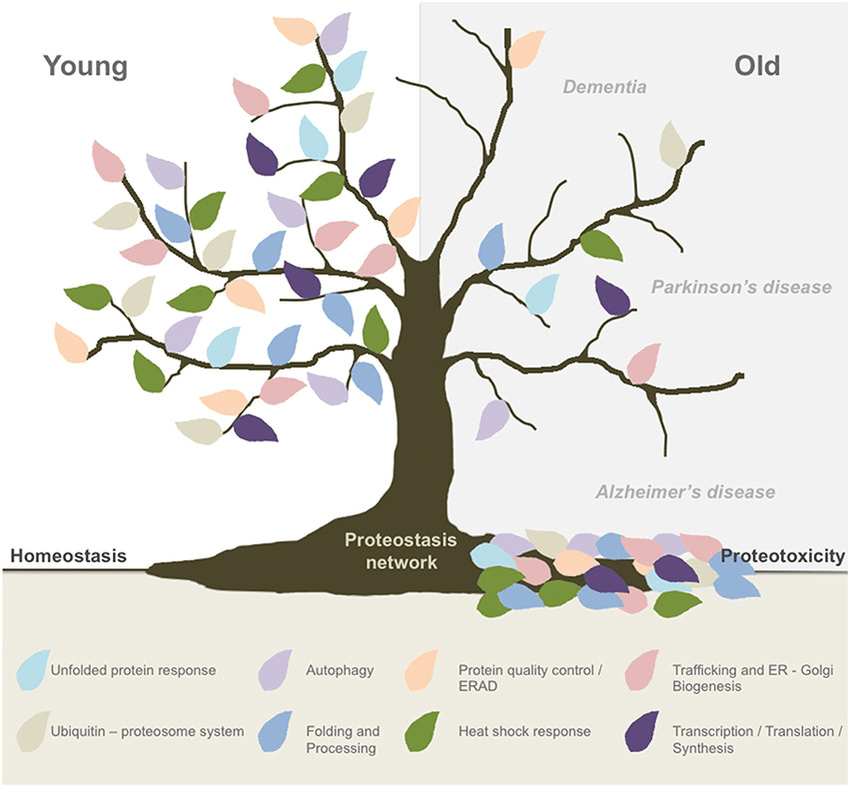
THE ABOVE PROCESSES ARE IMPORTANT IN THE DEVELOPMENT AND MAINTANCE OF PROTEINS.
The tree diagram of Proteostasis is a good summation of what happens when our proteins run into problems. When discussing Proteostasis we still do not have a good handle on the appropriate biomarkers of aging. Proteins and their problems are important for assessing aging but they still need leave much to be desired. The repair, recycling, and elimination of damaged macromolecules/organelles have emerged as key processes in maintaining cell integrity and function. At this time there are not really good biomarkers for Proteostasis.
MITOCHODRIAL AGING
Mitochondria influence or regulate a number of key aspects of aging and suggest that strategies directed at improving.
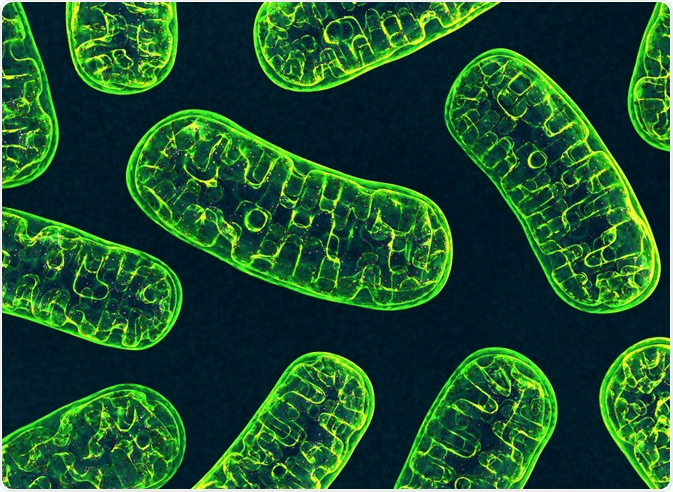
Mitochondrial quality and function might have far-reaching beneficial effects. Mitochondria are organelles found in all human cells, and their primary role is energy production through oxidative phosphorylation. They are also involved in signaling by producing ROS, as well as by regulating cellular metabolism, apoptosis‐programmed cell death, and other functions that are biologically important but cannot be reliably measured in real life.
The mitochondria seem to have a direct effect on most other aspects of aging. Their effects are far ranging since they influence almost all other aspects of aging from Telomere attrition to Stem Cell Exhaustion. This is easily seen on the following diagram.
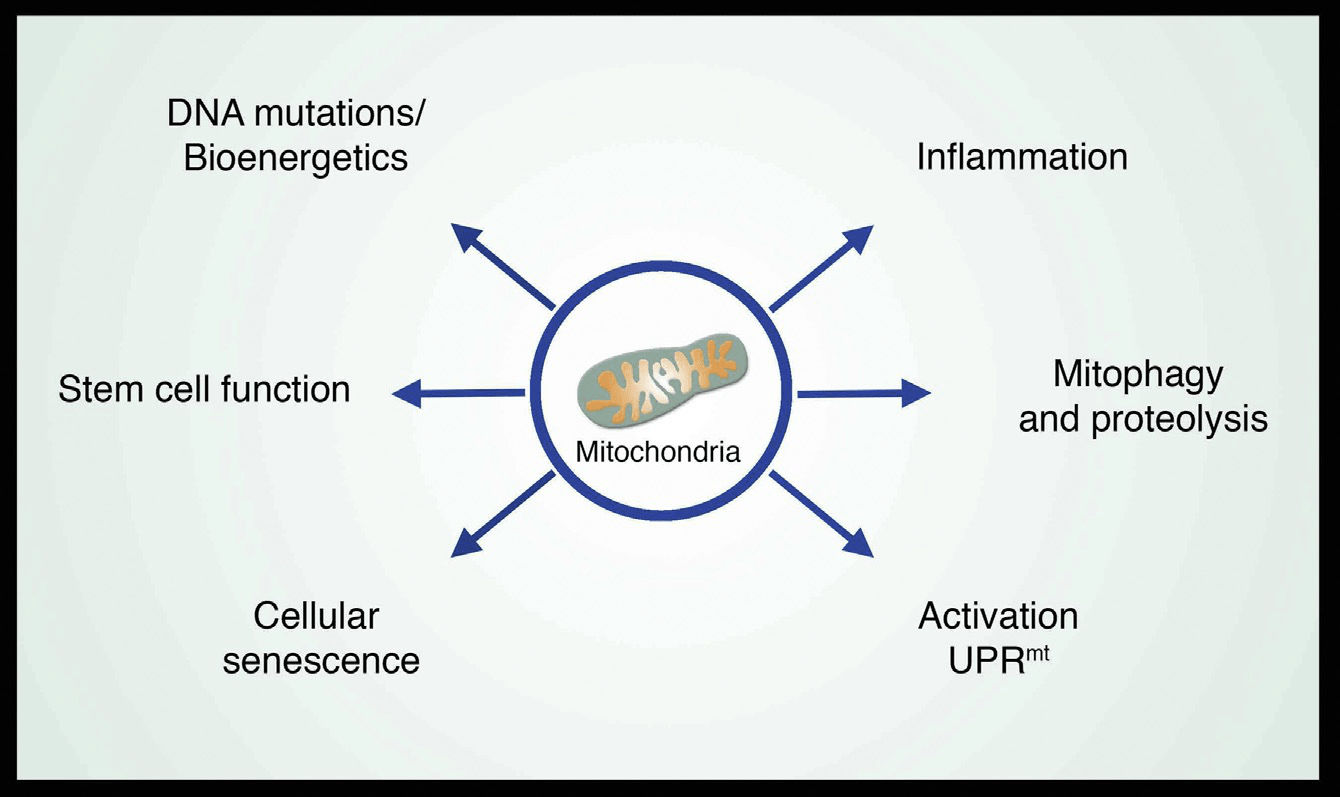
There still does not seem to be a consensus of opinion as what mitochondrial biomarkers are of value in assessing aging. However,we know that mitochondria are extremely important when dealing with aging. The mitochondrial theory of aging proposes that accumulation of damage to mitochondria and mitochondrial DNA (mtDNA) induces aging by reducing energy availability and increasing production of ROS that damage macromolecules. Unfortunately, these are difficult to measure. Luckily, there are a number of measures that can help keep mitochondria healthy. Many of these treatments are available in our clinic.
CELLULAR SENESCENCE
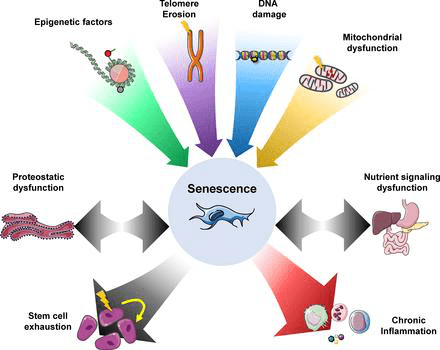
Cells continually experience stress and damage from exogenous and endogenous sources, and their responses range from complete recovery to cell death. Proliferating cells can initiate an additional response by adopting a state of permanent cell-cycle arrest that is termed cellular senescence. Aging is a complex biological process involving the continuous accumulation of changes in our bodies. Except for wrinkles and grey hair, among other changes in physical appearance, getting older also entails gradual deterioration of various bodily functions, leading to numerous age-related diseases and conditions. Although human aging is believed to go hand-in-hand with cellular senescence, what we currently know about this relationship is just the tip of the iceberg. Senescence is a key hallmark of chronological aging in humans, senescence levels may vary significantly between organs within the same person. Therein is where the problem lies. It is difficult to measure Senescence in humans. We can treat Senescent cells with Senolytic agents but we are still not sure if we are actually slowing down the clock of aging. Cellular senescence is a natural and irreversible process resulting from cells having the potential to multiply for only a limited number of times (also known as Hayflick limit). Senescent cells are old cells that can no longer divide. Even though the limited potential for division acts as a brake on old damaged cells from becoming cancerous, over time, senescent cells can cause damage to other cells and trigger aging and age-related illnesses. The problem with Senescence is that we do not have a good methodology of how to measure Senescence with biomarkers. Luckily, as was the case with mitochondrial aging we do have effective methods in our clinic to handle senescent cells.
Nutrient Sensing and Cell Communications
These are certainly important aspects of aging and manipulating these pathways can indeed have significant impacts on aging. Although these pathways produce measurable entities in the blood we cannot necessarily gain much information from their measurements. The reason for this is that these values are constantly changing depending on diet and exercise, even the time of the day. Thus, there are not dependable biomarkers.
STEM CELL EXHAUSTION
Stem cell exhaustion is influenced by the other pathways of aging. One of the most obvious characteristics of the aging process is the progressive decline in the regenerative potential of tissues. Adult stem cells are critical for rejuvenating tissues and persist throughout our lifespan. However, stem cell function declines during the aging process in tissues such as the brain, blood, skin, intestinal epithelium, bone, and skeletal muscle. This demise may contribute to tissue degeneration, organismal aging, and age-related diseases. Again, the problem is that there is no good biomarker test to assess stem cell exhaustion. Luckily, we have devised methods of maintain stem cell numbers by combinations of supplements and growth factor patches.
SAVING THE BEST FOR LAST
EPIGENETICS
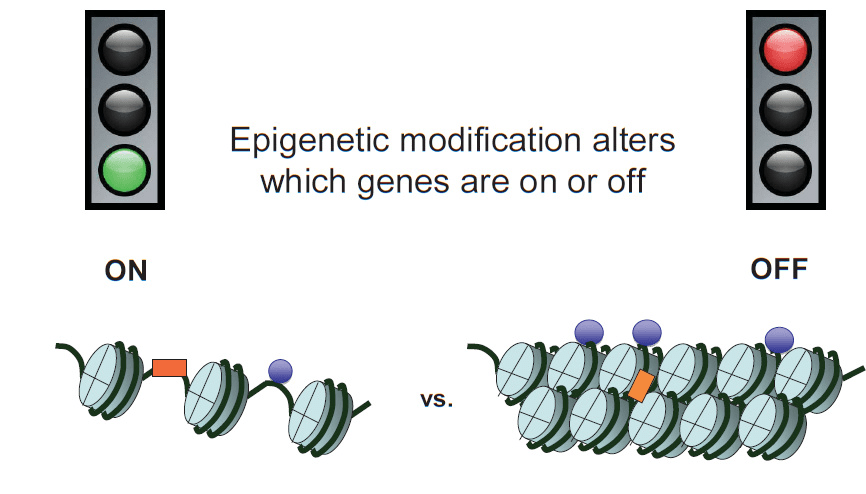
The term epigenetics encompasses the ensemble of mechanisms that modulate gene expression programs that adapt to environmental cues and define stable characteristics from differentiated cell types. Epigenetics seems like a concept pulled from a futuristic science-fiction movie where a drop of blood is fed into a machine, in which an algorithm churns through an accumulation of chemical groups coating a strand of DNA and spits out an individual's realistic age reflecting a lifetime of experiences and exposures. In simplistic terms, epigenetics involves putting a methyl group on a strand on DNA. A methyl group is a biochemical compound made from hydrogen and carbon. What we are really dealing with is called DNA methylation. DNA methylation occurs when a methyl group is added to a DNA strand. DNA methylation is a tool to typically lock genes into their off position. This is seen in the following illustration.
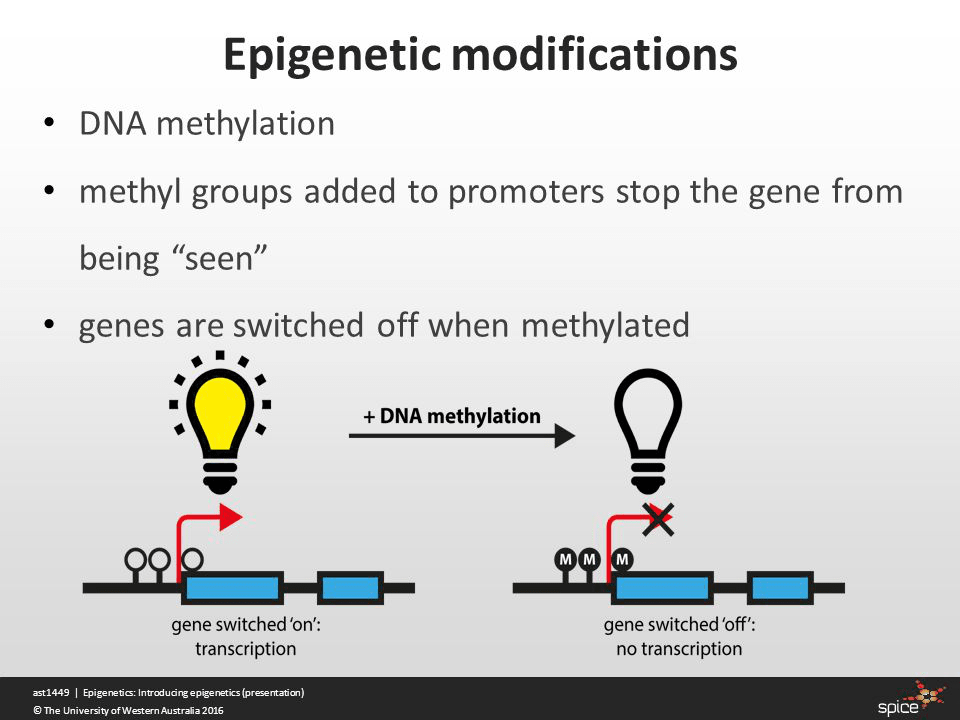
Aberrant DNA methylation, which is a nearly universal finding in cancer results in disturbed gene expression. DNA methylation is modified by environmental factors such as diet and exercise that may modify cancer risk and tumor behavior. Abnormal DNA methylation has been observed in several cancers. These alterations in DNA methylation may play a critical role in cancer development and progression. Dietary nutrient intake and bioactive food components are essential environmental factors that may influence DNA methylation. In recent decades, researchers have learned a great deal about DNA methylation, including how it occurs, where it occurs, and they have also discovered that methylation is an important component in numerous cellular processes. In the following illustration we see some aspects on how to influence epigenetic modulation. Actually, these will influence many of the pillars of aging.
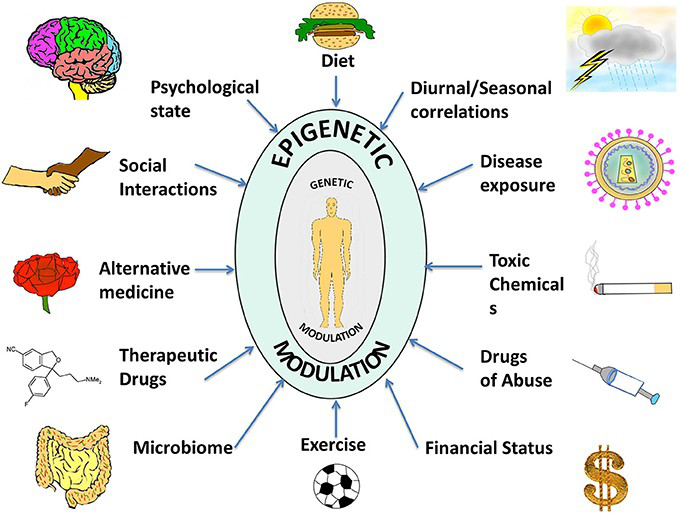
Epigenetic biological clocks have recently taken on a good bit of interest and importance. The three major influences on epigenetic clocks are DNA methylation, histone modification, and noncoding RNA. Among these three, a growing body of science emphasizes the role of DNA methylation in aging and age‐related chronic diseases in humans. In part, this is because DNA methylation is easily assessed in circulating cells and is relatively stable over time. Thus, it appears that as far as Epigenetics is concerned DNA methylation seems to be a realistic biomarker. It has everything we are looking for. The next diagram is a very realistic view of the Methylation Epigenetic Clock. We can see the protective factors and the risk factors. What we are able to do in our clinic is enhance the protective factors by modalities such as EBO2, V cells, and a host of intravenous products such as NAD.
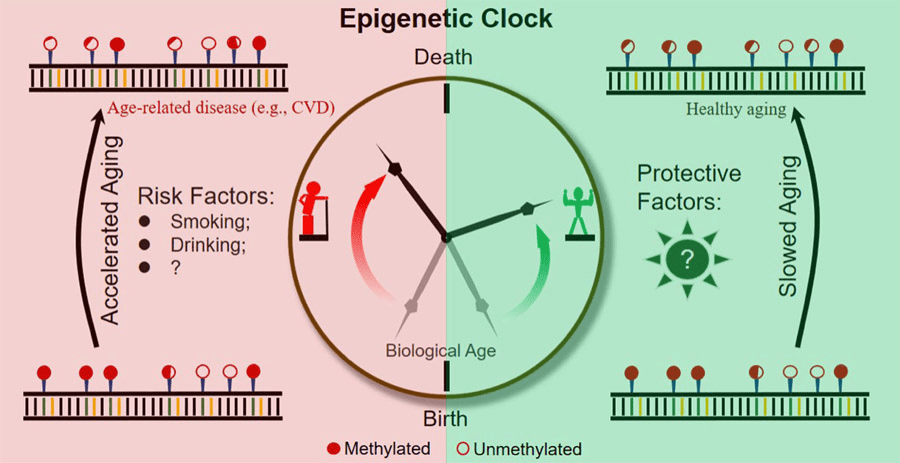
We now have at our disposal some real-time methods of measuring the DNA methylation clock. When talking about Methylation clocks there are a few different types. The main ones are called the Horvath and Hannan clocks.
The science community has known since the 1960s that DNA methylation has strong effects on aging. The first demonstration that DNA methylation levels can generate age predictors was published by a group of researchers at UCLA. They developed an “epigenetic clock” that analyzes the effects of age on tissues. A study conducted by Dr. Horvath found that women’s breast tissue ages faster than the rest of their bodies. They also found that cancerous tissue, on average, was 36 years older than other tissues. Overtime we have seen the development of several age estimators that use different sets of information from different tissues and age spectrums. The one we use looks at methylation markers which happen through epigenetics. This test was created by Dr. Steve Horvath and Dr. Greg Hannum in 2013. Dr. Horvath’s work has stood out in particular because of its ability to accurately predict age across all age types. Multi-tissue age estimator is first-ever accurate age predictor that works across most tissues and cell types. The epigenetic clock can officially predict one’s biological age with more accurately than chronological age and has shown that epigenetic age in humans can be reversed. Estimated DNA methylation age is associated with age-related conditions and predicts lifespan. The following is a diagram of different DNA methylation clocks. As can be seen there are three main clocks here. Our clinic is now offering DNA methylation tests which look at certain biomarkers. Biomarkers are able to capture aspects of biological aging.
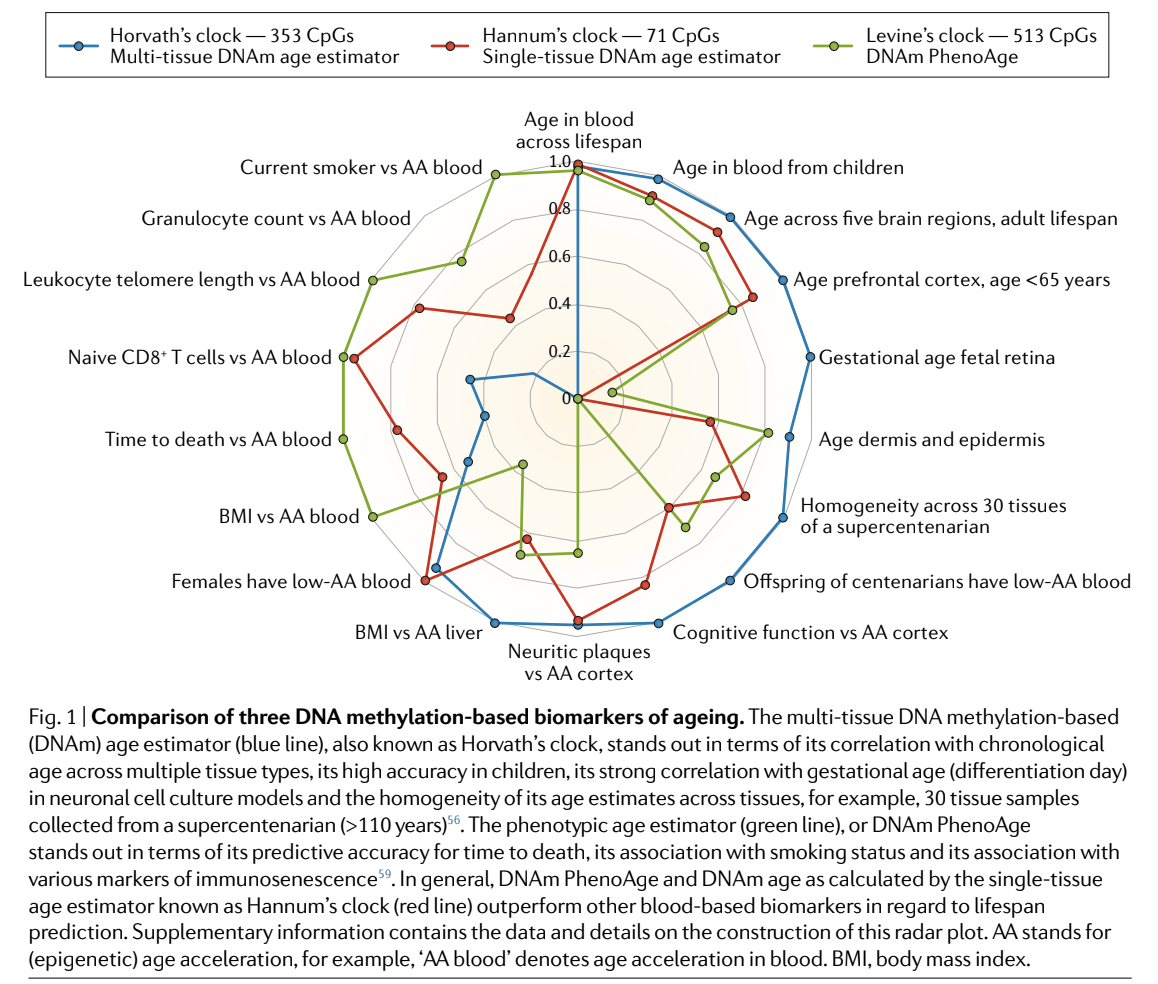
There is now a test to accurately measure DNA methylation. This is called the TruAgeTM test. TruAge uses blood to perform its analysis. It uses a powerful algorithm and computer learning software by analyzing almost a million data points from over 10,000 patients. By looking at how it has shown very tight correlations to chronological age and how the body methylates its DNA, TruDiagnosticTM is able to use their precise and reliable algorithm to predict one’s biological age. With the constant development of statistical technology and acknowledgment of aging and disease, we are now able to estimate biological age like never before.
How is this different from genetic testing like 23andMe? Genetics is the sequence of the DNA that you are born with and you die with. This means that our DNA sequencing is not influenceable, meaning you are stuck with it. But 60% of your DNA is controllable thanks to epigenetics. Due to epigenetics, we are able to have control over the way our genes are expressed, due to certain influences we put on the body. Lifestyle changes, such as diet and exercise, are one way we can influence gene expression. Other companies look at the genetic sequencing of an individual, which we have no control over. It is like knowing how a car engine works and finding out the motor stopped running but you aren’t given the tools to fix it. By addressing the modifiable parts of our DNA, we are able to take control of things like disease risk and rate of aging, rather than sitting by and waiting for problems to happen. DNA methylation is an excellent test but has its limits. For example, Horvat’s clock is based on the analysis of over 300 pieces of epigenetic information. One of the questions in the science of Anti-Aging medicine is the DNA methylation test may have too many components. Although it is comprehensive can we actually see if we are responsible for improvements that they patient might have with the various modalities that they may receive. DNA methylation is a very important weapon in our battle to control aging. There is already an excellent example of a clinical trial to reverse DNA methylation. This clinical trial is called the TRIIM TRIAL.
TRIIM TRIAL A COCKTAIL TO REVERSE METHYLATION

Based on an epigenetic age estimator, this is the first-ever and only report of an increase in human lifespan by means of anti-aging interventions. What medications have been shown to help reverse the epigenetic aging rate? Dr. Fahy and his team ran a small (9 patients) human clinical trial known as the Thymus Regeneration Immunorestoration, and Insulin Mitigation (TRIIM). The purpose of the TRIIM trial was to investigate if the immune system of older people could be rejuvenated to make them biologically younger and work better, as previously shown in mice. For one year, the 9 subjects took DHEA, metformin, and growth hormone, and on average, shed 2.5 years of their biological age. Based on an epigenetic age estimator, this is the first-ever and only report of an increase in human lifespan by means of aging interventions. It certainly will not be the last. Before you go out and use the medications used in the TRIIM trial a word of caution. Growth hormone may not always be anti-aging.
GLYCANAGE
It has been stated on many different occasions, sugar is the enemy of healthy living. This is certainly the case when we are assessing the GlycanAge of someone. Almost all proteins in our body are covered by sugar molecules, called glycans. If you study a protein without its glycan coat is like studying a bird without its feathers. These glucose molecules attach to proteins, resembling branches of a tree via highly complex process, called glycosylation. Glycosylation is the enzymatic process by which carbohydrates called glycans are attached to proteins or lipids, typically on the cell surface or in the bloodstream. This is an illustration of this:
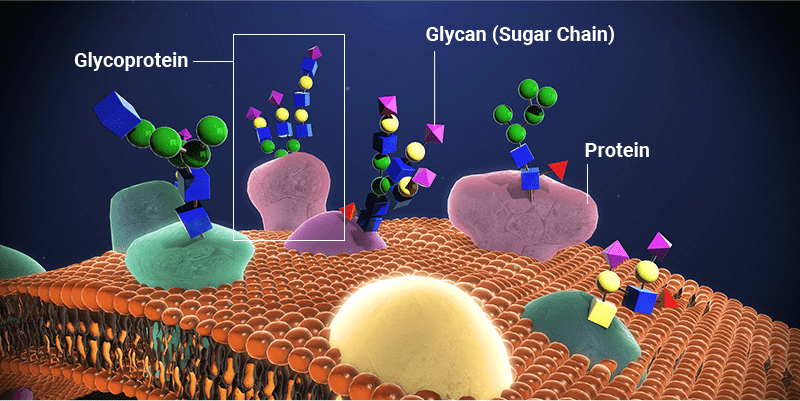
Our DNA dictates the protein structures in our bodies, but the proteins get further modified by the thick layer of glycans which are very much dependent on the lifestyle we live. Glycans play a vital role in keeping us healthy, but are also involved in most major diseases that affect mankind. As we age, the balance of pro-inflammatory and anti-inflammatory glycans in our body changes. Various inflammatory effectors provoke an imbalance between the two and lead to low-grade systematic inflammation, which can speed up the process of aging and lead to many diseases. The following chart is an excellent one when studying a patient’s bio markers. Glycans are impacted by a variety of genetic, biological and environmental factors, glycans are subject to change and the decisions you make can influence them! The following chart shows the Glycan aging biomarkers and how they seem to stand out.
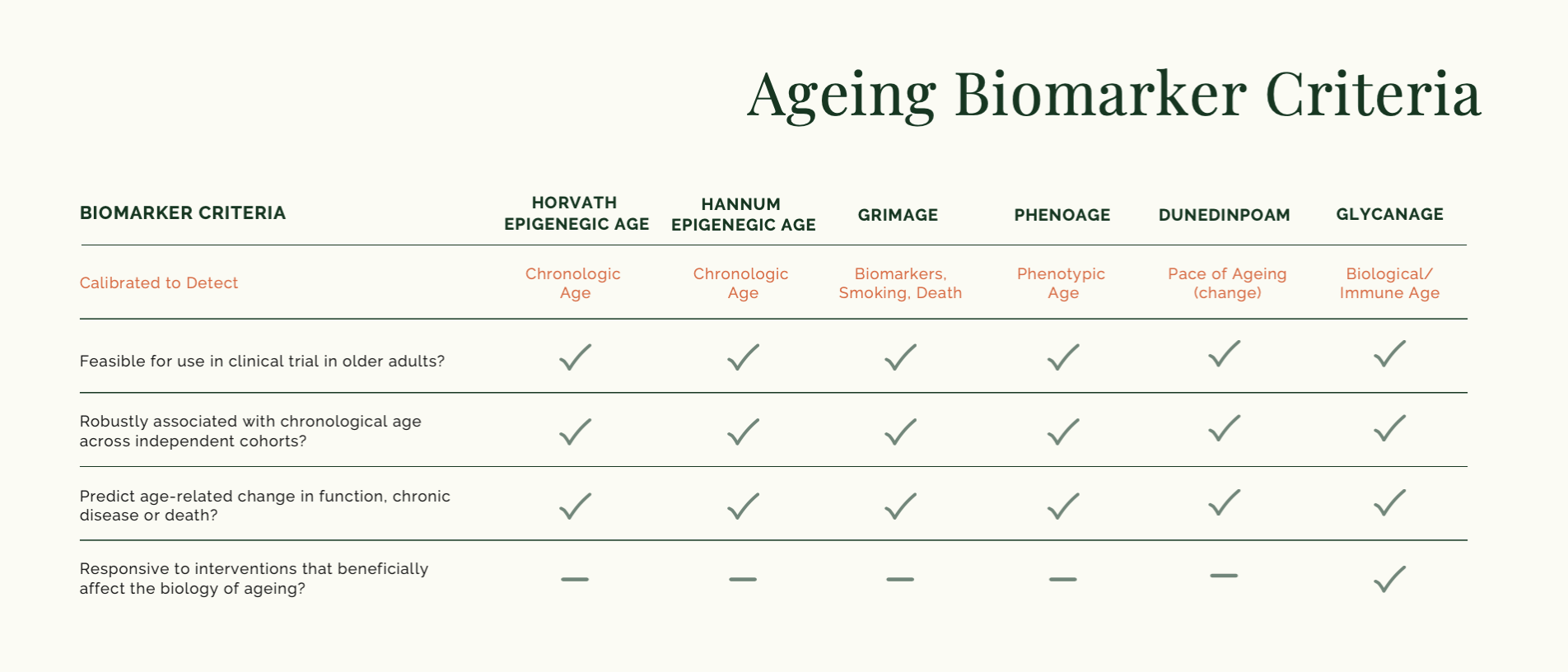
Glycan age markers are the only ones which seems to measure responsiveness to the interventions that beneficially affect the biology of aging. The bottom line is unless you are able to see how your intervention is working you are working as if you had blindfolds on.
GlycanAge is different because it measures your IgG glycosylation, which directly correlates with the level of inflammation in your body. IgGs are a type of antibody representing approximately 75% of the antibodies found in the serum. In humans, IgG is the most common type of antibody found in blood circulation. It is instrumental in fighting most infections. It will give you information about the immune balance of your body that changes with age, health and life circumstances. GlycanAge is based on a single molecule and its functional regulation. While the methylation clock measures information, Glycanage measures direct effectors. In other words, how different treatments one receives affects their aging. An individual's repertoire of glycans changes with age and environmental factors such as such as smoking and poor diet. The type of glycans attached to IgGs affects their pro- and anti-inflammatory properties. A serious problem associated with glycosylation is the production of what are called “ADVANCED GLYCATION END PRODUCTS” (AGES). This occurs when the sugars bind to proteins causing a host of problems as can be seen in the following diagram. Advanced glycation end products (AGEs) are proteins or lipids that become glycated as a result of exposure to sugars. They are a bio-marker implicated in aging and the development, or worsening, of many degenerative diseases, such as diabetes, atherosclerosis, chronic kidney disease, and Alzheimer's disease. Animal-derived foods that are high in fat and protein are generally AGE-rich and prone to new AGE formation during cooking. In particular, grilling, broiling, roasting, searing, and frying propagate and accelerate new AGE formation. The following diagram shows the variety of the clinical manifestations of glycosylation.

Getting back to the GlycanAge test, only a few drops of blood are needed. Since environmental factors heavily influence glycosylation and since glycan patterns can change relatively quickly (compared to DNA methylation), this might be an even better test for assessing whether your new workout regimen or favorite supplements are working their best for you. The information on the difference between a person's biological and chronological age, enriched with other data (clinical parameters, dietary info, exercise regime etc.) and targeted interpretation can serve a wide spectrum of applications. For instance, one application is “Lifestyle Assessment – a way to healthy ageing. After having received the information on the general health status by GlycanAge® test, the subject has an opportunity to make necessary changes in their lifestyle (regarding exercise, diet, sleep, tobacco exposure, stress etc.) with the aim of improving their general health status. Another important application is “Sports Diagnostics” - GlycanAge offers the users (amateur and professional athletes, sports coaches, athletic trainers etc.) an insight into the health aspect of training (microtraumas, overtraining etc.) thereby enabling the creation of a more appropriate personalized training plan.
When all is said and done, the best method to assess one’s biological age is to use a combination of both the TruAge test for checking on DNA methylation and the GlycanAge test to check glycosylation levels. The more information we have the more potential we have to improve your health. We are very excited about these new tools. DR. P
